Allgemeine SS M36 Chained Service Dagger
CATEGORY: Version
SKU: 50.GOR.02.04.01.02.001.000
Estimated market value:
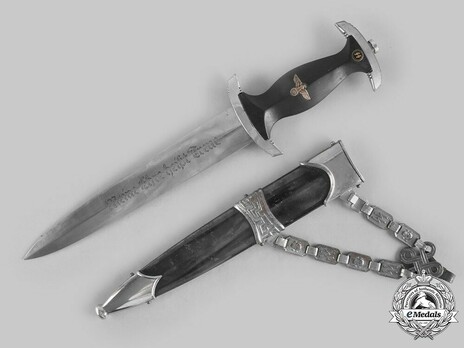
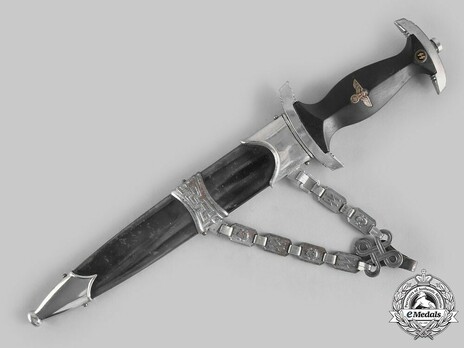
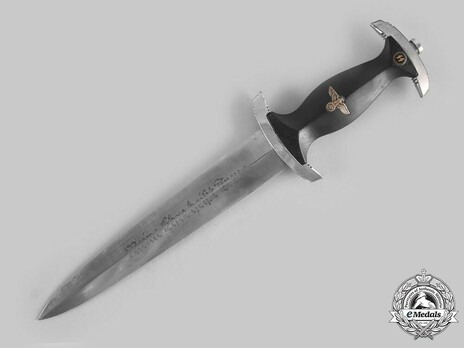
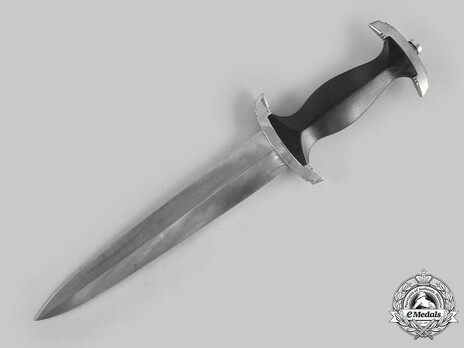
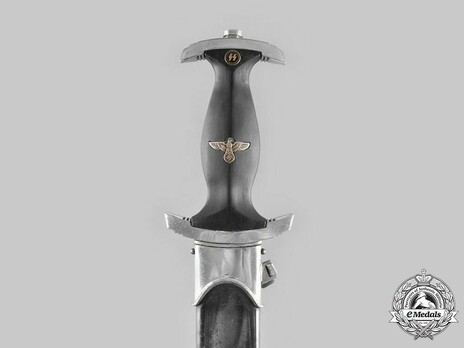
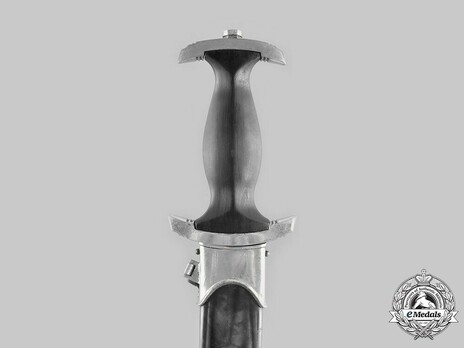
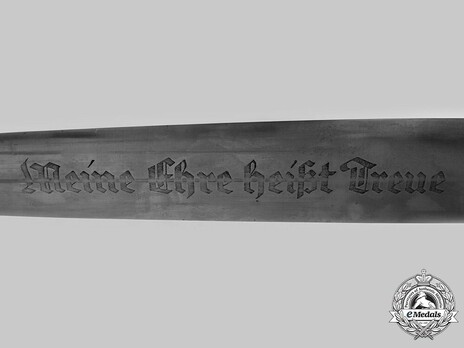
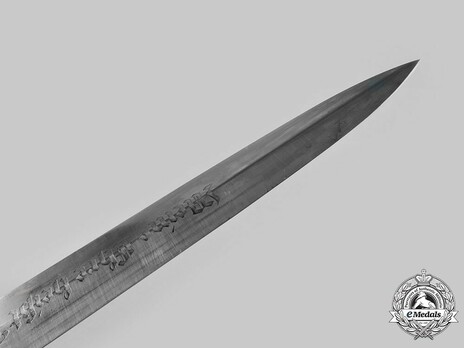
Estimated market value:
A well-preserved Model 1936 Chained SS Dagger, measuring 470 mm in total length when inserted into the scabbard. It features a 220 mm-long magnetic metal blade with a sharpened tip and semi-sharpened edges. The obverse features an acid-etched inscription of “MEINE EHRE HEIßT TREUE” (“MY HONOUR IS LOYALTY”) in Fraktur script. The blade sits securely within the upper crossguard, constructed of silver-plated feinzink and marked with eight notches, with four distributed at both the top and bottom. The handle consists of a blackened wooden grip, inset with dual insignia. The latter includes a copper German national eagle clutching a wreathed mobile swastika, measuring 25 mm (w) x 15 mm (h), as well as a blackened SS rune insignia near the pommel, measuring 10 mm in diameter. The dagger completes with a silvered feinzink lower crossguard, similarly marked with eight notches, and a rounded pommel nut securely maintaining the overall structure. It is accompanied by its period original scabbard, constructed of a black painted magnetic metal shaft. The tip of the shaft bears a polished magnetic metal fixture, secured in place by dual side rivets. Two additional polished magnetic metal fixtures are secured to the throat and upper third of the scabbard, similarly with two side rivets each. These fixtures bear integrated rectangular loops connecting to a chain. The chain consists of six magnetic metal links, with three bearing raised Totenkopfs and three bearing SS rune insignia. The chain connects to a functional spring clip, with the exterior bearing a decorative knotted swastika. One link is marked on the reverse with a SS Kulturzeichen. The scabbard throat retains a functional spring catch, securely holding the dagger in place during storage. While well-preserved, issues consistent with age and use are evident, and include running marks to the blade, oxidation and consequent loss of finish to the feinzink elements, and oxidation of the magnetic metal. The dagger is in an overall very fine condition.
Introduction
The first model of the SS Service Dagger was designed and approved alongside the very similar SA dagger in the second half of 1933. However, it first became available for purchase in early 1934. The official order that introduced both the SS and SA daggers was signed on December 15, 1933.
The right to wear an SS dagger was granted upon induction into the SS.
The dagger was worn by Officers, Non-Commissioned Officers (NCOs) and Enlisted Men (EMs) alike in both the Allgemeine SS and later the Waffen-SS.
Officers had to purchase theirs. If they were financially unable to do so, they were given a loan, which would then be paid back in instalments. If NCOs and EMs had the financial means, they were allowed to purchase their own dagger. If not, however, SS units kept a small contingent of daggers for this scenario. These daggers were borrowed by those men who couldn’t afford a dagger of their own and had to be returned eventually.
Daggers could not be purchased in regular retail stores, but had to be ordered through official channels that were controlled by the RZM (Reichszeugmeisterei = national quartermaster’s office).
Some daggers are personalised. An example would be the stamping of the wearer’s SS identification number somewhere on the dagger, often the crossguard. Some daggers were dedicated by a friend or the men of a commander’s unit. Some have other interesting markings, for example the names of the SS Sports School Fürth or the SS Junker (officer candidate) Schools Bad Tölz and Braunschweig.
On incredibly rare occasions, personalised daggers (that are not Damascus-Bladed Honour Daggers) will feature a Damascus-style weld patterned blade.
Appearance
The upper and lower crossguard used on the hilt of early M33 daggers were cast. The same is true for the tang nut. They were made of what is known as nickel-silver, German silver, or alpaca, which is an alloy that actually doesn’t contain any silver at all, but copper, nickel, and zinc.
Some crossguards received a chrome finish. By 1936, to accommodate the need to supply a growing SS force, some methods to cut cost and labour were introduced, resulting in overall lower quality production. Crossguards were now often made via injection molding, using light weight pot metal, zinc, or aluminum, sometimes lightly nickel-plated to appear to have been made of superior materials.
The reverse of the lower crossguard may carry a Roman numeral, either I, II, or III, which may identify a distribution area. I is the most common, followed by III, while II is quite rare.
They may have been applied by the RZM. Some crossguards are stamped with Arabic numerals, but their purpose is unknown (except on dedicated daggers, see specific products for more information).
Another part of the dagger that was made of nickel-silver is the scabbard fittings, being stamped from metal sheets. Some scabbard fittings received a chrome finish. Later scabbard fittings were made of just nickel to keep production costs lower.
The scabbard’s throat contains an inner sleeve to retain the spring scabbard liner/runners. Early sleeves were made of nickel-silver, while later ones were made of steel. Early runners were made of brass, while later runners were often made of aluminum.
The scabbards were made of different materials, usually steel, however, some very early examples were made of brass.
Early scabbards were chemically blued and then lacquered to achieve their colour. However, this process was time-consuming, so later scabbards were instead spray-painted black. The blued scabbards also did not hold their finish very well even during the short period of the Third Reich, and so today they are often found with partial loss of their colour. Some were painted over in black in the 1930s or 40s. Intact blued scabbards are rarely found today.
Some companies used up stocks of blued scabbards well into the late 1930s, so that late M33 daggers, as well as M36 daggers, can sometimes be found with them.
The grip is made from wood that has been dyed black. The obverse contains a button featuring the SS runes at the top and a national eagle emblem with a swastika in the centre.
The blade is forged from steel. Very high quality materials were used with the earliest daggers, but progressively the quality declined. All SS daggers have the organisation’s motto, “Meine Ehre heißt Treue” (my honour is loyalty) in Gothic letters acid-etched onto the obverse blade. A somewhat rare variation is an additional exclamation mark after the motto. The maker’s mark and RZM code on the reverse of the blade were applied in the same way.
Makers
Almost all companies producing SS daggers were situated in the city of Solingen, where traditionally all sorts of knives and blades were manufactured. Solingen has therefore been nicknamed the “city of blades”.
Early daggers feature the manufacturing company’s logo as a maker mark on the reverse blade, just under the cross guard. At some point, the RZM introduced individual codes for each company to use instead of their maker marks. Initially after this change, some companies would double mark their daggers with the RZM code and their company logo, but this practice was forbidden at some point and didn’t occur anymore, certainly not after 1940.
While there are some exceptions to this rule, in general an RZM code would be of the following pattern: RZM logo - 1164/38 SS, with the number part differing for each manufacturer and the two digits after the stroke standing for the year of production. Since an official period list of all codes has not been found, the holders of several codes are still unknown. A list of known manufacturers’ codes can be found in Thomas T. Wittmann’s “Exploring the Dress Daggers and Swords of the German SS”, page 162.
Most early M33 daggers available today were produced by the following makers: Carl Eickhorn; Richard Abraham Herder; Heinrich Böker; Robert Klaas.
Less common are: Gottlieb Hammesfahr; Ernst Pack & Söhne; Carl Bertram Reinhard & Sohn; as well as these yet to be identified makers that are only known by their RZM codes: RZM 120/34 SS; RZM 121/23 SS; SS 188/35 RZM.
Producers that are rarely encountered today are: Artur Schüttelhöfer (ASSO); Jacobs & Co.; Eduard Gembruch; Friedrich Herder A. S.
Extremely rare are daggers by: Weyersberg, Kirschbaum & Cie. (WKC); F. W. Backhaus; Lauterjung & Sohn (Puma); Carl Julius Krebs; Wilhelm Kober (situated in Suhl); Klittermann & Moog; Louis Perlmann (Louper).
This list of makers is not a definitive one and may be added to in the future.
The order that approved the Model 1936 Chained Dagger was given on August 25, 1936.
All Officers were eligible to carry it who held an Officer rank since no later than November 9, 1935, as well as all other SS members, provided they had been part of the organisation for at least three years.
Grips, crossguards, and tang nuts of the M36 dagger were the same as those used for M33 daggers, except that M36 crossguards did not feature Roman district numbers. However, they do sometimes feature a stamped Gau (district) abbreviation mark, similar to SA daggers.
As has been mentioned, some M36 dagger scabbards were chemically blued, while most were spray-painted black.
The M36’s most outstanding new feature is of course the integral chain hanger. The chains are attached to the scabbard fittings. The upper chain part is attached via an open square-shaped link to the upper scabbard fitting, while the lower chain is connected to a newly introduced centre mount via a normal chain connecting link. The centre mount features a connecting swastikas relief.
The chain parts are made up of octagonal plates that are held together by connecting links. There are two plates for the top chain part and four for the lower chain part. The plates feature alternating skull with crossbones and SS runes motifs.
The chains are attached to a cloverleaf-shaped structure often referred to as “Wotan’s Knot”. The Knot itself is soldered on to a snap clip.
Often, an SS proof stamp inside a small octagon can be found on the reverse of the second chain plate of the upper chain.
There are two types of chain assemblies. Earlier Type I chains have thicker connecting links, slightly larger skulls with crossbones and SS runes on their plates, and slightly larger Wotan’s Knots. On Type II chains, the upper circle of the Knot isn’t open, obscuring the snap clip below. However, the most obvious difference is that the connection links between the Knot and the first chain plates on each side are bevel-trimmed, while those on Type I chains are straight.
Type II chains are much more common than Type I chains.
M36 daggers can be encountered with a maker mark, an RZM code-style mark, or no mark at all.

Comments
Sign in to comment and reply.



Scroll Top